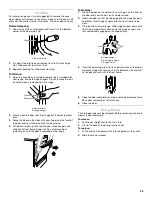
21
To Modify Sequence Programming:
1. Press DELETE STEP.
The last step of the sequence will be canceled, and the step
prior to the canceled sequence will show on the display for
either review or modification.
If the programmed sequence has not been started, see “To
Program Steps 2, 3 and 4 of the Sequence” section to
program a step to replace the canceled cook function.
2. Press START.
The first step will show on the display and the program
sequence will begin.
Changes can be made during a programmed cook function;
however, changes cannot be made after a programmed cook
function has been completed.
If at any time during an active sequenced program ADD STEP
is pressed, 3 tones will sound.
Warming Drawer
(on some models)
The Warming Drawer is ideal for keeping hot cooked foods at
serving temperature. It may also be used for warming breads and
pastries.
Different types of food may be placed in the warming drawer at
the same time. For best results, do not hold foods longer than
1 hour. For smaller quantities or heat-sensitive foods, such as
eggs, do not hold longer than 30 minutes.
Food must be at serving temperature before being placed in the
warming drawer. Breads, pastries, and fruit pies may be heated
from room temperature on the HI setting.
Remove food from plastic bags and place in oven-safe container.
Cover foods with a lid or aluminum foil.
Do not cover with plastic wrap.
Empty serving dishes and oven proof dishes can be heated while
the warming drawer is preheating.
Before using the warming drawer, wash the tray that lines the
bottom of the drawer with soap and water. See “General
Cleaning” section.
To Use:
1. Place cooked food(s) in warming drawer.
2. Press DRAWER WARM.
WARM DRAWER will appear on the display.
3. Press START.
WARM DRAWER will appear on the display.
4. Press DRAWER OFF when finished.
The Warming Drawer operates at 170ºF (80ºC) only.
RANGE CARE
Self-Cleaning Cycle
(on some models)
IMPORTANT: The health of some birds is extremely sensitive to
the fumes given off during the Self-Cleaning cycle. Exposure to
the fumes may result in death to certain birds. Always move birds
to another closed and well ventilated room.
Self-clean the oven before it becomes heavily soiled. Heavy soil
results in longer cleaning and more smoke.
Keep the kitchen well-ventilated during the Self-Cleaning cycle to
help get rid of heat, odors, and smoke.
Do not block the oven vent(s) during the Self-Cleaning cycle. Air
must be able to move freely. Depending on your model, see
“Oven Vent” or “Oven Vents” section.
Do not clean, rub, damage or move the oven door gasket. The
door gasket is essential for a good seal.
Prepare Oven:
■
Remove the broiler pan, grid, cookware and bakeware and,
on some models, the temperature probe from the oven.
■
Remove any foil from the oven because it may burn or melt,
damaging the oven.
■
Remove oven racks to keep them shiny and easy to slide.
See “General Cleaning” section for more information.
■
Hand clean inside door edge and the 1½" (3.8 cm) area
around the inside oven cavity frame, being careful not to
move or bend the gasket. This area does not get hot enough
during self-cleaning to remove soil. Do not let water, cleaner,
etc. enter slots on door frame. Use a damp cloth to clean this
area.
■
Wipe out any loose soil to reduce smoke and avoid damage.
At high temperatures, foods react with porcelain. Staining,
etching, pitting or faint white spots can result. This will not
affect cooking performance.
WARNING
Food Poisoning Hazard
Do not let food sit for more than one hour before or
after cooking.
Doing so can result in food poisoning or sickness.
WARNING
Burn Hazard
Do not touch the oven during the Self-Cleaning cycle.
Keep children away from oven during
Self-Cleaning cycle.
Failure to follow these instructions can result in burns.






















